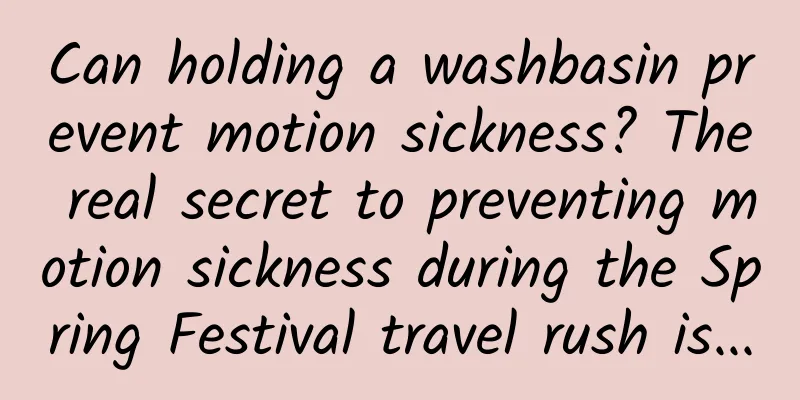Can holding a washbasin prevent motion sickness? The real secret to preventing motion sickness during the Spring Festival travel rush is...

|
This year's Spring Festival travel season will last for 40 days, from January 14 to February 22. It is expected that the cross-regional flow of people in society will reach a record 9 billion. In such a large-scale event, one kind of travel trouble has also ushered in a high incidence, that is - "motion sickness"! Why do we get carsick? Motion sickness is just a common name. In fact, the official name is "motion sickness" (MS). It generally refers to a series of physiological reactions such as dizziness, nausea, vomiting, pale face, cold sweats, etc. caused by the human body's incorrect perception of motion due to multiple factors. Although it is called a disease, it is not a disease in essence. Motion sickness occurs not only when riding in a car, but also when riding other means of transportation. The probability of seasickness is even higher. A very small number of people also experience airsickness. The exact cause of motion sickness is still unclear. Scientists have proposed various hypotheses, including the vestibular organ's oversensitivity and the otolith weightlessness hypothesis. At present, the more popular view is that the essence of motion sickness is the conflict between the vestibular system of the inner ear and visual perception, or the conflict between the brain's expectations and perceptions. When we sit in a speeding car, our eyes see the relatively static interior space, while the vestibular system senses the vehicle's acceleration, deceleration, and turning. This inconsistency in perception confuses the brain. During the long process of evolution, mammals have developed a sophisticated balance perception system. The vestibular system consists of three semicircular canals and otoliths, which are responsible for sensing the rotation and acceleration of the head. The visual system captures external information through the eyes, and the proprioceptive system senses the position and movement of the body through muscles, joints and skin. The coordinated operation of these three systems allows us to move freely in space. However, the emergence of modern transportation has broken this balance. The enclosed space of the carriage makes the visual system lose external references, while the frequent speed changes and turns of the vehicle continue to stimulate the vestibular system. Some scientists speculate that the symptoms of nausea and vomiting that occur when motion sickness occurs are actually a primitive physiological reaction. During the evolutionary process, if this kind of perception split occurs, the mammalian brain will mistakenly think that the body may be poisoned, which will then trigger protective reactions such as nausea and vomiting. How to prevent motion sickness? 1. State and diet before the trip Before embarking on a journey, being well prepared is the key to preventing motion sickness. Get enough sleep and rest the day before and avoid excessive fatigue. When you are tired, your body's tolerance will be reduced, making you more prone to motion sickness. You should not be too full or too hungry before taking a ride. Being too full may cause stomach discomfort, while being too hungry may aggravate the discomfort of motion sickness due to low blood sugar. It is recommended to choose light and easily digestible food and avoid greasy, spicy and irritating food. 2. Motion sickness medicine If you have a history of motion sickness, you can prepare motion sickness medicine. Common motion sickness medicines are mainly divided into antihistamines, anticholinergics, etc. Antihistamines such as diphenhydramine and dimenhydrinate can reduce dizziness and vomiting caused by motion sickness by inhibiting histamine receptors. Anticholinergics such as scopolamine can relieve nausea and vomiting by reducing the excitability of the parasympathetic nerves. Generally, motion sickness medicine can be taken half an hour to an hour in advance and taken as needed. However, it should be noted that motion sickness medicine may have some side effects, such as drowsiness, dry mouth, etc., and should not be taken in excess. 3. Things to note when riding During the ride, choosing a suitable seat can effectively reduce the symptoms of motion sickness. If you are taking a bus, try to sit in the front row of the vehicle, close to the window, which can not only reduce the bumps and vibrations, but also open the window for ventilation. At the same time, keep your head close to the back of the chair, avoid shaking violently, and blend into the vehicle as much as possible. Many people who suffer from motion sickness do not have symptoms of motion sickness when they drive themselves. Therefore, if you are sitting in the passenger seat of a car, you can try to imagine yourself as the driver, look into the distance, and let your brain have a sense of the movement of the vehicle. In order to make the brain more convinced that you are driving, you can also take a virtual steering wheel, or a round object such as a washbasin, and pretend to drive. As long as the brain can predict the movement changes, it will have a certain effect. In addition, it is also very important to keep the air circulating in the car. Fresh air can reduce the nausea caused by lack of oxygen or odor stimulation. Avoid reading books, looking at mobile phones or playing electronic devices in the car. These behaviors will make the eyes focus on close objects, further aggravating the incoordination between the inner ear and vision. You can also use some natural smells to relieve motion sickness. For example, smell fresh orange peels, lemon slices, wind oil or cooling oil under your nose. These fresh smells can stimulate the olfactory nerves and relieve nausea. There are also reports that ginger has a certain natural antiemetic effect. If you are motion sick, you can prepare some ginger slices to take or some ginger products such as ginger candy. Although the method is questionable, it will at least have some psychological suggestion effects. 4. Psychological adjustment Motion sickness is not only a physiological reaction, but also closely related to psychological factors. Some people even experience motion sickness when they see a car or smell gasoline. This is actually psychological suggestion. Therefore, before taking a ride, you should keep a relaxed state of mind and avoid excessive anxiety or tension. You can distract yourself by listening to music, chatting with others, etc., relax your mood, and avoid paying too much attention to the discomfort of motion sickness. Of course, during the Spring Festival, the best antidote for motion sickness is everyone's desire for family reunion. I hope that after reading this article, every friend on the journey will have a safe and happy journey home. |
>>: My skin is dry in winter, should I apply a facial mask every day?
Recommend
Experts reveal the truth about 9 major rumors about osteoporosis
Medical data show that 50% of osteoporosis patien...
Apple introduces major functional and design improvements to the official Weather app in iOS 15
After acquiring the meteor weather app Dark Sky i...
Xianyu no-source e-commerce screen domination + instant store operation operation course collection (operation video + materials)
Xianyu no-source e-commerce screen domination + i...
How much does it cost to join a restaurant kitchen app in Jixi?
For entrepreneurs, although mini program developm...
Looking back | It was expelled from the "planet" 16 years ago, and it "made a heart" to you from 6 billion kilometers away
16 years ago, August 24, 2006, was destined to go...
World Quantum Day丨What is the difference between quantum measurement and ordinary measurement?
April 14 is World Quantum Day. Why was this date ...
GAC Aion's 480kW super-fast charger will be mass-produced in September, with a charging range of 200km in 5 minutes and a service life of up to 1 million km
GAC Aion’s super-fast charging technology is arri...
Why does the world map only have 4 colors?
On a world map, how many colors are needed to col...
APP User Experience Report | Xianyu, how to play with the idle community?
In this article, the author analyzes Xianyu’s use...
It's loquat season again. Have you tried them yet? Let's take a look at a scientific mystery caused by loquat...
Author: Liu Su (Shanghai Chenshan Botanical Garde...
Talk from 8 perspectives: Channel delivery methods based on user journey
The user journey refers to the entire process of ...
91 Ten Articles: Weilai's profit per vehicle is about 77,500 yuan, and the think tank believes that Tesla will withdraw from China in the future
1. In the first quarter of 2021, new car sales in...
Pan Yi's Basic TCM Training Camp Video
Pan Yi's Basic TCM Training Camp Video Pan Yi...
There are many benefits to being hungry! Not only does it help you lose weight, it also helps you live longer!
"Don't let yourself go hungry!" Thi...
If you have tested positive, can you take off your mask when you go home for the Spring Festival? Latest answers from experts →
During the Spring Festival, the mobility of peopl...









